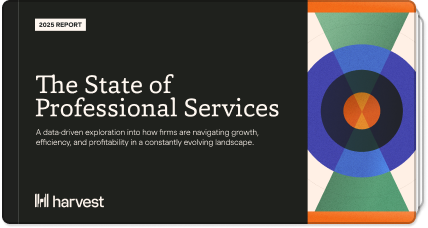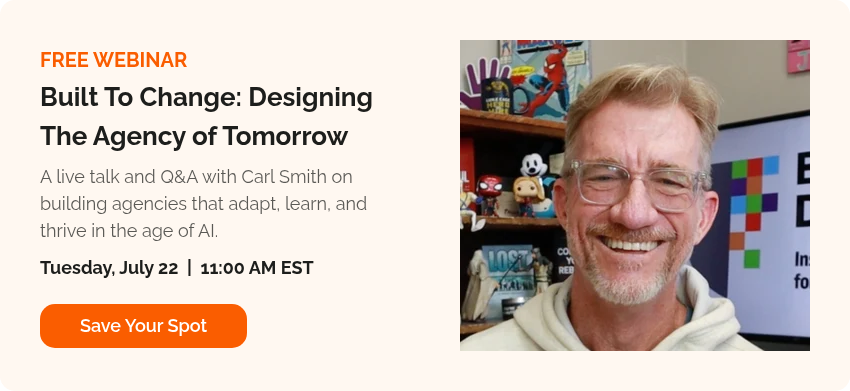Carl Smith has spent the better part of his career watching digital agencies rise, fall, and reinvent themselves. Whether running his own agency or leading The Bureau (formerly Bureau of Digital), a community of 8,000+ agency owners and leaders, he’s had a front-row seat to every major shift in the professional services landscape—from the dot-com boom to the pandemic pivot and today’s AI revolution.
But according to Carl, what we’re witnessing now is much bigger than just another cyclical change. “We’re in the middle of a fundamental restructuring of how agencies operate, price their services, and define their relationships with clients,” says Carl. “The agencies that thrive in this new reality will look radically different from the ones that dominated the last decade.”
His insights about agency structure, client relationships, and the role of technology aren’t just theoretical; they’re grounded in real conversations with hundreds of agency leaders navigating these changes in real time. His takes are honest and might make you uncomfortable. And if you know Carl, you know that he’s okay with that.
The Old Agency Model Is Breaking Down
The days of the rigid agency model are numbered. “If you’re looking at agencies five years from now, they're going to have to be built to change,” Carl says.
Carl Smith’s vision for agency transformation centers on three non-negotiables: radical transparency in client relationships, accountability-driven pricing models, and AI integration that amplifies human creativity rather than replacing it. The agencies clinging to billable hours and black-box processes aren't just falling behind—they risk becoming irrelevant to clients who now expect partnership, not just execution.
This isn’t just about being flexible when clients request revisions or pivoting during economic downturns. “I’m talking about something more fundamental—agencies that can restructure their pricing, reshape their service offerings, and reimagine their client relationships as the market demands it,” he explains.
Remote work has redefined collaboration, AI is accelerating the pace of change, and a new generation of clients is entering the market with completely different expectations.
“The way things used to work won’t sync with Gen Z clients that don’t just want a pitch and a price. They want context and insights,” Carl explains. The new expectation is to go beyond just delivering, but also helping clients think. The way agencies have traditionally done business development and execution will have to change to meet this new normal.
AI Is an Input, Not an Output
While some agency leaders are either panicking about AI or dismissing it entirely, Carl sees a more nuanced reality emerging. His perspective: “AI is an input, not an output.”
“Agencies that treat AI as a collaborator rather than a crutch will retain their soul and differentiation,” Carl explains. The key distinction is whether you're using AI to enhance human creativity or replace it entirely.
This shift is already playing out in practical ways across agency operations. Take project management, for example. “Project management is being redefined by AI,” Carl observes. Instead of spending their days updating spreadsheets and chasing down status updates, AI can handle the mechanical aspects of resourcing and task tracking. “This frees up their time to do things like managing client expectations, navigating team dynamics, and solving the challenges that no algorithm can address: human dynamics.”
The agencies that get this balance right will do more than just survive the AI revolution—they’ll be able to deliver better strategic thinking and stronger client relationships because they’re freed from administrative busywork to focus on what humans do best.
Honest Expectations > Oversized Promises
After years of seeing agencies chase growth at all costs, Carl is witnessing something unexpected in the agency world: a return to fundamentals that’s powered by true transparency.
“Transparency is the new trust-builder in client relationships,” Carl says. This goes far beyond sharing project timelines or budget breakdowns. Agencies are opening up about everything from their pricing models to how they're using AI in their work. The honesty extends beyond internal operations to external client relationships, creating a level of openness that would have made agency leaders uncomfortable just a few years ago.
We’re seeing a return to craft in the agency world. When agencies stop hiding behind polished facades and start being honest about their processes, capabilities, and even limitations, they can focus on what originally drew them to this business—the work itself.
This radical transparency is enabling something even more significant: “We’re seeing a return to craft in the agency world,” Carl notes. “When agencies stop hiding behind polished facades and start being honest about their processes, capabilities, and even limitations, they can focus on what originally drew them to this business—the work itself.”
Carl is seeing shops re-center on why they started: the creativity, the problem-solving, the distinctiveness that made them want to build an agency in the first place. They’re doubling down on what they do exceptionally well and being transparent about what they don't. Being everything to everyone just won’t work anymore.
The result? Clients who know exactly what they're getting, agencies who can focus on their strengths, and relationships built on honest expectations rather than oversized promises.
Clients Expect You To Be Using AI—If You’re Not, They’ll Wonder Why
The conversation around AI in agencies has shifted dramatically. Where once agencies worried about whether clients would accept AI-assisted work, Carl is seeing the opposite concern emerge: “Clients expect you to be using AI—if you’re not, they'll wonder why.”
This represents a fundamental change in client expectations. AI has gone from “tolerated” to “expected.” Clients understand that AI can make work faster, more efficient, and often more thorough. When agencies resist using these tools, clients don’t see it as maintaining quality standards; they see it as falling behind.
But here’s where it gets interesting: the expectation isn’t that agencies should replace human thinking with AI. Instead, clients want to see agencies using AI intelligently while still delivering distinctly human value. “The key is being upfront about how you’re using it and still delivering human value,” Carl explains.
This transparency about AI usage ties directly back to the trust-building that Carl believes is so important. Clients want to know that their agency is leveraging the best available tools while still bringing strategic thinking, creative problem-solving, and industry expertise that no algorithm can replicate.
“The agencies that thrive in this new reality aren’t the ones avoiding AI or the ones letting it do all the work—they’e the ones being honest about how they're using it to amplify their human capabilities. They’re showing clients exactly where AI adds efficiency and where human insight drives the real value,” says Carl.
Accountability-Based Pricing Is What’s Next
Perhaps Carl’s most radical prediction challenges the very foundation of how agencies price their work: “We’re entering the era of accountability-based pricing.”
It’s a fundamental shift toward shared responsibility that goes beyond the pricing model. “I think the pricing models have to ebb and flow with who did what they said they were going to and who dropped the ball,” Carl explains. When the client falters, they bear some responsibility. When the agency falters, they do too.
The technology to make this work is already here. Carl envisions AI tools updating dashboards in real time with KPIs that track not just project progress, but accountability markers for both parties. Did the client approve designs on schedule? Did the agency deliver quality work on time? These factors would directly influence pricing.
“What they can’t have is privacy and trying to hide whatever happened,” Carl emphasizes. “They need to be partners for each other in accountability as well as in business.” This level of transparency eliminates the traditional dynamic where agencies absorb all the risk regardless of client behavior.
The shift makes sense given the speed of modern business. “The speed to market is so much faster with the AI tools,” Carl notes. When everything moves faster—from ideation to execution to market testing—traditional pricing models that ignore partner accountability become unfair and counterproductive.
Carl admits this is his “favorite part” of the conversation because it addresses one of the industry’s most persistent problems: projects that succeed or fail based on client engagement, not just agency performance. When pricing reflects actual contributions from both sides, everyone has skin in the game to perform at their best.
The Future Is Transparent, Accountable, and Built to Adapt
If you’re leading an agency today, change is coming. Are you building the transparency, adaptability, and human-centered processes that will define the next decade of client relationships? This transformation starts with examining your current client relationships through the lens of genuine partnership rather than vendor dynamics.
To learn more about and become a part of Carl’s organization, The Bureau, visit their website or follow them on LinkedIn.
Harvest helps agencies track, report, and optimize their work with the kind of transparency that builds lasting client partnerships. Get started with a free trial today.
















